Festival business plan for starting your own business
The purpose of this business plan for a music festival is to outline the steps necessary to launch a successful festival business. The plan will cover topics such as the mission and vision of the business, the target market, the organizational structure, the financial plan, the marketing strategy, and the operational plan. Additionally, the plan will provide a timeline for achieving the goals of the festival business.
This nightclub business plan will provide a blueprint for success and will be used for obtaining funding, recruiting employees, and managing the business’s daily operations. It is essential that the business plan is kept up-to-date to ensure that the business remains competitive and profitable.
2. Executive Summary
The Business
Festival Productions is a full-service event planning and management business specializing in creating and organizing large festivals and other events. Festival Productions will provide a complete package of event planning, coordinating, and management services to ensure each event is successful.
Our team is made up of experienced professionals who are passionate about creating memorable events. We comprehensively understand the event planning process and will use our expertise to help our clients create a successful event.
The food festival business plan aims to maintain a strong online presence and use social media to promote our services, increase brand awareness, and communicate with our clients. We will also use traditional marketing techniques such as print and radio advertising to reach potential new customers.
Business Target
Our target market consists of music enthusiasts of all ages, sizes, and backgrounds. We plan to cater to a diverse demographic with various musical genres, ranging from classic rock to EDM and everything in between.
The film festival business plan pdf also plans to target local businesses, as well as national and international brands, to create a unique sponsorship opportunity. The festival will be held in the City of Los Angeles and will attract attendees from throughout the Los Angeles area, as well as from across the country and worldwide.
Our main goals are to be the leading event production company in the region, to provide our clients with the highest quality service, and to ensure that every event we produce is a success.
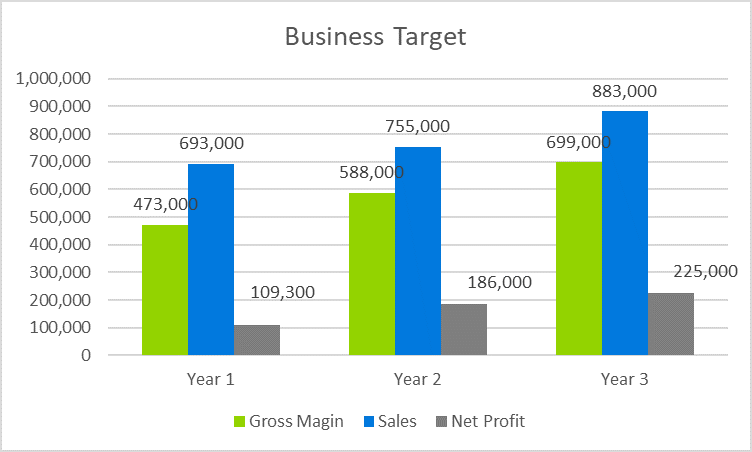
3. Company Summary
Company Owner
Festival Productions is a startup company founded by two entrepreneurs, Joe and Sam. Joe and Sam have the vision to create a unique event experience for their customers.
The company focuses on creating innovative and entertaining events that bring people together and create unforgettable memories. The company will provide a wide range of services to ensure that its events are successful and profitable. These services include event planning, budgeting, marketing, and customer service.
Why The Festival Business Is Being Started
The festival business is being started with the goal of creating a unique event experience that will bring people together and create unforgettable memories.
The music festival business plan template will create events that will be enjoyable and exciting for both the customer and the company. This will be done by providing a high-quality and unique experience that will bring people together and create lasting relationships.
How The Festival Business Will Be Started
The community festival business plan will be started by first obtaining the necessary licenses and permits for the event. The company will then begin to plan the event by hiring event planners and budgeting for the event.
The company will then begin to market the event by creating promotional materials and advertising. The company will also create a customer service team to ensure that customers have a pleasant and enjoyable experience.
Note
Finally, the company will work to ensure a successful and profitable event by monitoring the event and tracking the results.
Financial experts help festival business owners estimate starting costs, including investments, loans, and assets.
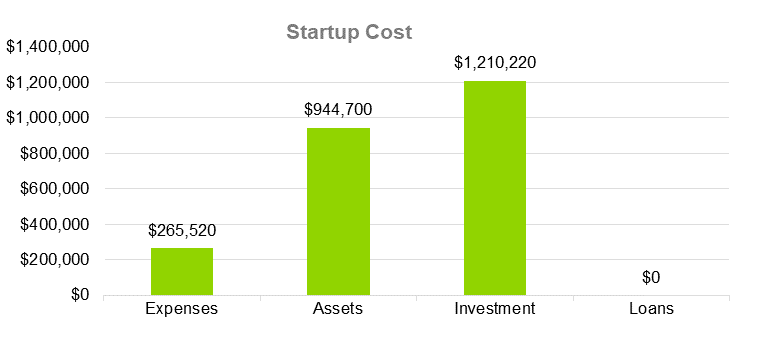
As part of the start-up requirements for an arts and crafts festival business plan, this information includes the following: startup expenses, assets, start-up funding, startup funding requirements, assets, liabilities, planned investments, capital, liabilities, and funding requirements.
| Start-up Expenses | |
| Legal | $142,300 |
| Consultants | $0 |
| Insurance | $19,200 |
| Rent | $53,400 |
| Research and Development | $13,800 |
| Expensed Equipment | $32,900 |
| Signs | $3,920 |
| TOTAL START-UP EXPENSES | $265,520 |
| Start-up Assets | $263,000 |
| Cash Required | $173,000 |
| Start-up Inventory | $31,100 |
| Other Current Assets | $225,000 |
| Long-term Assets | $252,600 |
| TOTAL ASSETS | $944,700 |
| Total Requirements | $1,210,220 |
| START-UP FUNDING | |
| Start-up Expenses to Fund | $265,520 |
| Start-up Assets to Fund | $944,700 |
| TOTAL FUNDING REQUIRED | $1,210,220 |
| Assets | |
| Non-cash Assets from Start-up | $1,238,800 |
| Cash Requirements from Start-up | $299,500 |
| Additional Cash Raised | $48,330 |
| Cash Balance on Starting Date | $36,700 |
| TOTAL ASSETS | $1,623,330 |
| Liabilities and Capital | |
| Liabilities | $20,000 |
| Current Borrowing | $0 |
| Long-term Liabilities | $0 |
| Accounts Payable (Outstanding Bills) | $52,000 |
| Other Current Liabilities (interest-free) | $0 |
| TOTAL LIABILITIES | $72,000 |
| Capital | |
| Planned Investment | $1,210,220 |
| Investor 1 | $0 |
| Investor 2 | $0 |
| Other | $0 |
| Additional Investment Requirement | $0 |
| TOTAL PLANNED INVESTMENT | $1,210,220 |
| Loss at Start-up (Start-up Expenses) | $341,110 |
| TOTAL CAPITAL | $1,551,330 |
| TOTAL CAPITAL AND LIABILITIES | $1,623,330 |
| Total Funding | $1,210,220 |
4. Services
The purpose of the music festival business plan sample is to attract potential investors and give stakeholders a glimpse of the company’s strategies, goals, and financial projections. The children’s festival business plan services provide comprehensive solutions for festival organizers to execute successful events. These services include
- Event Management: Providing professional services to organize and manage all aspects of festivals, including entertainment scheduling, venue selection, marketing, budgeting, and more.
- Ticket Sales: Selling tickets to festival events, online and in-person.
- Vendor Relations: Developing and maintaining relationships with vendors, ensuring that all vendors meet all regulatory requirements and festival standards.
- Venue Management: Identifying and securing venues for festival events, ensuring that all necessary permits and licenses are in place.
- Event Promotion: Creating and executing marketing plans to promote the festival, including social media campaigns and print materials.
- Branding: Developing and managing the festival’s brand identity and messaging.
- Community Outreach: Developing relationships with local businesses, organizations, and government entities to ensure a successful and well-attended festival.
- Risk Management: Creating and implementing policies, procedures, and protocols to mitigate risk and ensure a safe and secure festival.
- Logistics: Managing all logistical aspects of the festival, including transportation, catering, security, and more.
- Compliance: Ensuring that all vendors, contractors, and other personnel comply with applicable laws and regulations.
- Budgeting: Developing and managing the festival’s budget to ensure that all costs are tracked and accounted for.
excellent work
excellent work, competent advice.
Alex is very friendly, great communication.
100% I recommend CGS capital.
Thank you so much for your hard work!
5. Marketing Analysis
One of the most important components of how to do a business plan for a festival is the marketing analysis it provides.
Market Trends
The music festival industry has seen rapid growth in the last decade due to the increasing popularity of digital music platforms such as Spotify and Apple Music. This has caused a rise in live music events as people are looking for ways to experience music in a more engaging way.
Marketing Segmentation
The pride festival business plan can be segmented by age, gender, location, and type of event. Age-wise, younger generations are more likely to attend festivals, while those in their 30s and 40s are more likely to attend more traditional music concerts. Gender-wise, males are more likely to attend large-scale events, while females are more likely to attend smaller, more intimate gatherings. Location-wise, festivals tend to be concentrated in urban areas with a high concentration of young people. However, festivals are increasingly being held in rural areas as well. Type of event-wise, festivals can range from music to food and cultural.
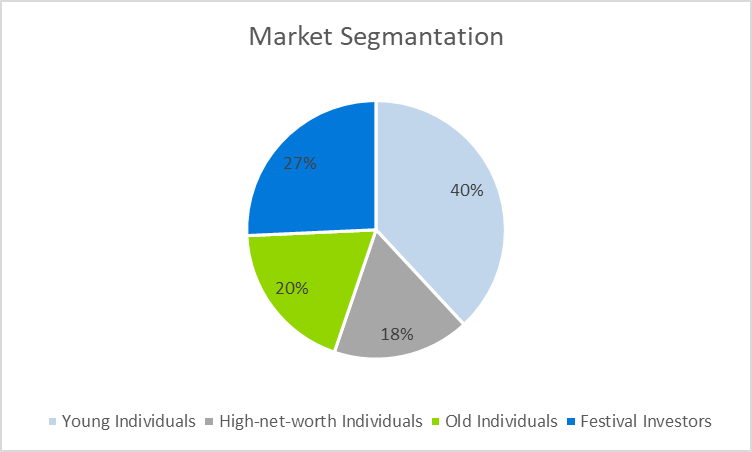
Business Target
The primary target audience for the music venue business plan is young adults aged 18-35 who are looking for a unique, memorable experience. This audience is likely to be tech-savvy and active on social media, and they are likely to be open to new experiences and innovative ideas. The secondary target audience is adults aged 35-60 who may be looking for a more traditional music festival experience.
Product Pricing
The pricing of festival tickets and other related products should be based on the type of event, the size and scope of the event, and the amenities provided. Ticket prices should be set to cover the cost of organizing the event and to ensure a reasonable profit margin.
| Market Analysis | |||||||
| Potential Customers | Growth | Year 1 | Year 2 | Year 3 | Year 4 | Year 5 | CAGR |
| Young Individuals | 40% | 35,500 | 42,600 | 51,120 | 61,344 | 73,613 | 10.00% |
| High-net-worth Individuals | 18% | 35,250 | 42,300 | 50,760 | 60,912 | 73,094 | 10.00% |
| Old Individuals | 20% | 25,950 | 31,140 | 37,368 | 44,842 | 53,810 | 10.00% |
| Festival Investors | 27% | 17,400 | 20,880 | 25,056 | 30,067 | 36,081 | 11.00% |
| Total | 100% | 114,100 | 136,920 | 164,304 | 197,165 | 236,598 | 10% |
6. Marketing Strategy
Competitive Analysis
In the beer festival business plan pdf, there is a lot of competition. To be successful, it is important to understand the local competition and its strategies. A thorough analysis of the local competition should be conducted to identify their strengths and weaknesses. This information should then be used to create a competitive advantage and develop a sales strategy to best position the festival business.
Sales Strategy
The sales strategy should focus on identifying the target market, creating a unique selling proposition, and developing a comprehensive marketing and promotional plan. The target market should be identified based on demographics, interests, and festival type.
The unique selling proposition should be developed to emphasize the festival’s unique features and benefits. The marketing and promotional plan should be developed to reach the target market, generate interest, and create awareness of the festival.
Sales Monthly
The sales monthly plan for how to craft a business plan for a festival should include specific goals and objectives for each month. These goals should focus on increasing the number of attendees, ticket sales, and revenue.
Each month, specific actions should be taken to reach these goals, such as developing and executing promotional campaigns, creating special offers, and utilizing social media. Based on the experts’ opinions, monthly sales are expected.
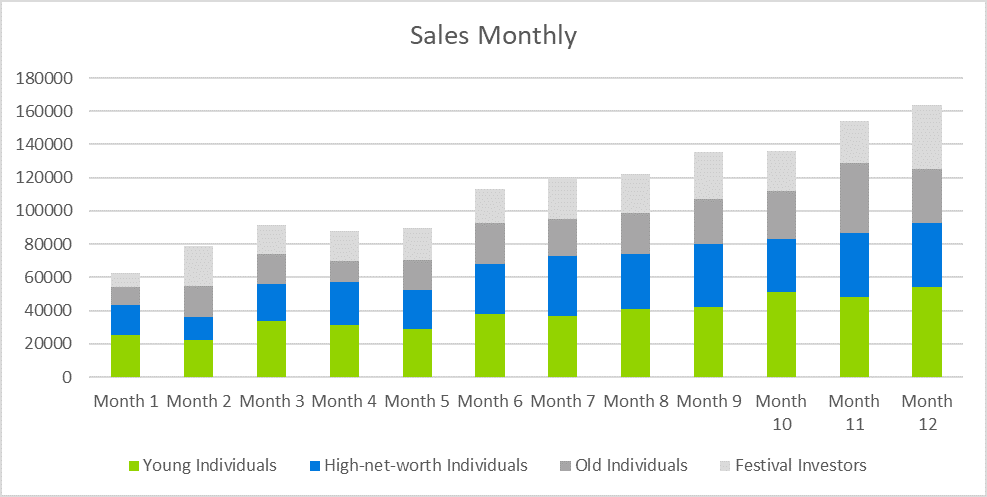
Sales Yearly
The sales yearly plan should focus on maximizing the revenue for the entire year. According to the experts’ estimates, the following sales are expected yearly.
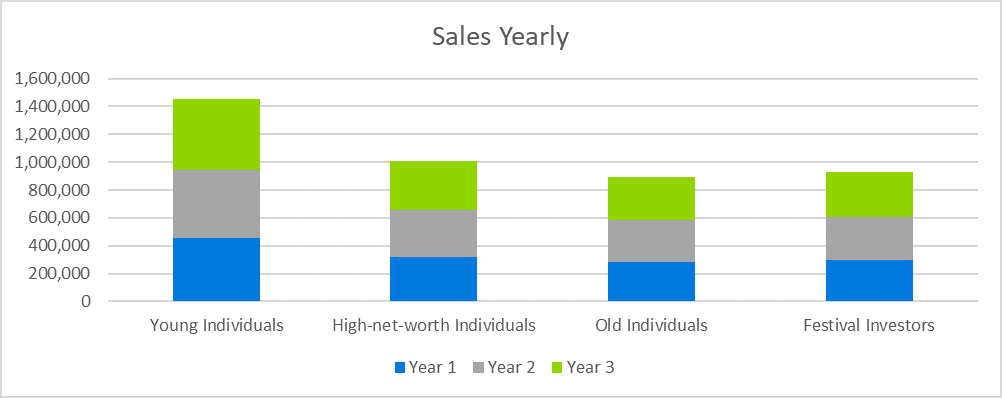
Sales Forecast
The forecast should provide an indication of the expected revenue, number of attendees, and other important metrics. This forecast should be updated regularly to ensure accuracy. Sales are forecasted as follows:
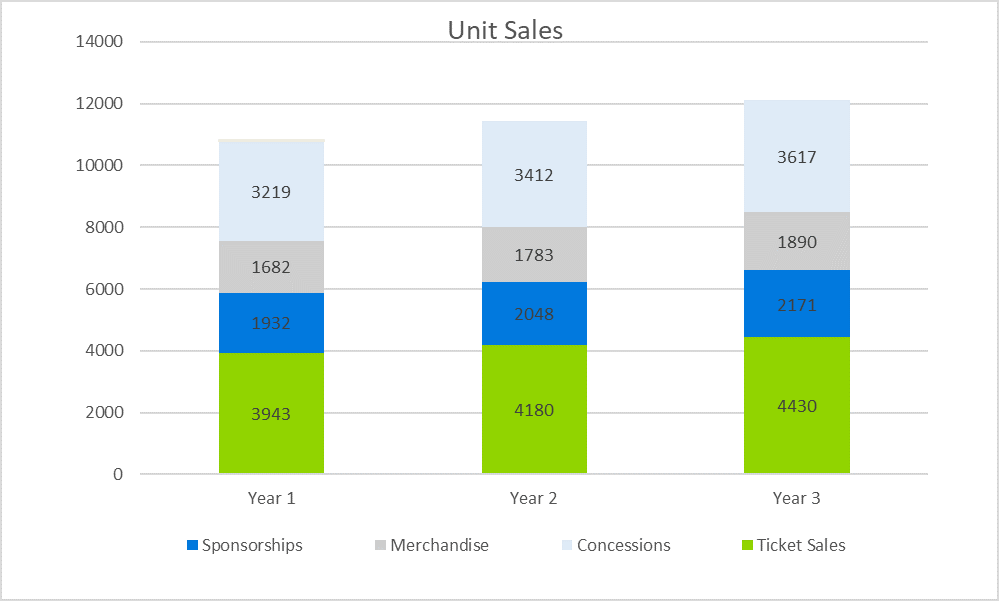
| Sales Forecast | |||
| Unit Sales | Year 1 | Year 2 | Year 3 |
| Ticket Sales | 3,943 | 4,180 | 4,430 |
| Sponsorships | 1,932 | 2,048 | 2,171 |
| Merchandise | 1,682 | 1,783 | 1,890 |
| Concessions | 3,219 | 3,412 | 3,617 |
| TOTAL UNIT SALES | 10,776 | 11,423 | 12,108 |
| Unit Prices | Year 1 | Year 2 | Year 3 |
| Ticket Sales | $482.00 | $559.12 | $648.58 |
| Sponsorships | $1,684.00 | $1,953.44 | $2,265.99 |
| Merchandise | $452.00 | $524.32 | $608.21 |
| Concessions | $937.00 | $1,086.92 | $1,260.83 |
| Sales | |||
| Ticket Sales | $1,900,526.00 | $2,336,886.77 | $2,873,435.97 |
| Sponsorships | $3,253,488.00 | $4,000,488.84 | $4,919,001.08 |
| Merchandise | $760,264.00 | $934,820.61 | $1,149,455.43 |
| Concessions | $3,016,203.00 | $3,708,723.21 | $4,560,246.06 |
| TOTAL SALES | $8,930,481.00 | $10,980,919.44 | $13,502,138.54 |
| Direct Unit Costs | Year 1 | Year 2 | Year 3 |
| Ticket Sales | $400.00 | $440.00 | $462.00 |
| Sponsorships | $1,567.00 | $1,723.70 | $1,809.89 |
| Merchandise | $459.00 | $504.90 | $530.15 |
| Concessions | $897.00 | $986.70 | $1,036.04 |
| Direct Cost of Sales | |||
| Ticket Sales | $1,577,200.00 | $1,839,015.20 | $2,046,823.92 |
| Sponsorships | $3,027,444.00 | $3,529,999.70 | $3,928,889.67 |
| Merchandise | $772,038.00 | $900,196.31 | $1,001,918.49 |
| Concessions | $2,887,443.00 | $3,366,758.54 | $3,747,202.25 |
| Subtotal Direct Cost of Sales | $8,264,125.00 | $9,635,969.75 | $10,724,834.33 |
7. Personnel Plan
Company Staff
Festival Productions is proud to have a team of dedicated and experienced event professionals. Our team consists of:
- CEO
- CFO
The management staff includes;
- Event Manager
- Marketing Manager
- Public Relations Manager
- Production Manager
- Logistics Manager
- Security Manager
- Vendors Manager
- Technical Manager
- Operations Manager
- HR Manager
- Social Media Manager
- Food and Beverage Manager
The operational team includes;
- Financial Officer
- Graphic Designer
- Web Developer
- Volunteers Coordinator
Other Staff includes;
- Administrative Assistant
- Accountant
- Receptionist
- Cleaning Staff
Average Salary of Employees
The average salary of employees for a science festival business plan depends on the size and scope of the festival. For a small-scale festival, employees may receive an hourly wage. Employees may receive a salary or a combination of a salary and commission for a large-scale festival. The average salary of employees also depends on their specific job role. For example, a festival manager may receive a higher salary than a ticketing staff member. In addition, salaries may vary depending on the festival’s location and the employee’s level of experience.
| Personnel Plan | |||
| Year 1 | Year 2 | Year 3 | |
| CEO | $55,000 | $60,500 | $66,550 |
| Chief Financial Officer | $48,000 | $52,800 | $58,080 |
| Marketing Manager | $47,000 | $51,700 | $56,870 |
| Operation Manager | $35,000 | $38,500 | $42,350 |
| Investment Manager | $30,000 | $33,000 | $36,300 |
| Other Management | $200,000 | $220,000 | $242,000 |
| Operational Team | $100,000 | $110,000 | $121,000 |
| Other Staff | $60,000 | $66,000 | $72,600 |
| Volunteers Coordinator | $80,000 | $88,000 | $96,800 |
| Total Salaries | $655,000 | $720,500 | $792,550 |
8. Financial Plan
Our financial plan is designed to ensure that our festival is profitable and sustainable. Our revenue will come from ticket sales, sponsorships, merchandise sales, and concessions. We project that our total revenues will be maximum in the average length of time to create a festival business plan.
Important Assumptions
A financial plan for the festival business should be calculated as follows:
| General Assumptions | |||
| Year 1 | Year 2 | Year 3 | |
| Plan Month | 1 | 2 | 3 |
| Current Interest Rate | 8.55% | 8.58% | 8.59% |
| Long-term Interest Rate | 7.21% | 7.26% | 7.28% |
| Tax Rate | 21.06% | 21.08% | 21.09% |
| Other | 0 | 0 | 0 |
Nevertheless, deviations will be kept to levels that won’t affect the company’s major financial strategies.
Brake-even Analysis
Based on the fixed and variable costs of the karaoke business plan, the following is a breakdown:
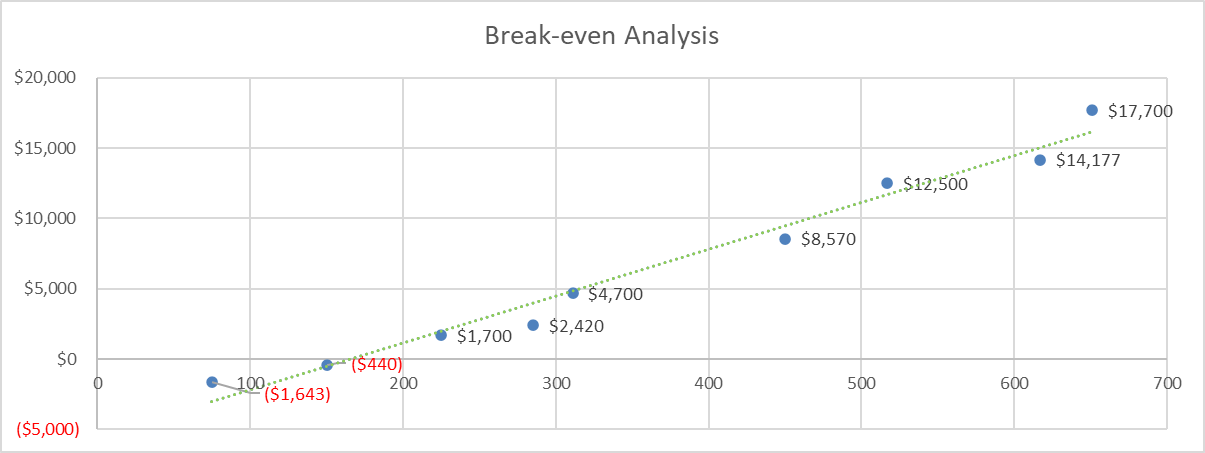
As shown in the following table, monthly break-evens are analyzed
| Break-Even Analysis | |
| Monthly Units Break-even | 4597 |
| Monthly Revenue Break-even | $188,534 |
| Assumptions: | |
| Average Per-Unit Revenue | $371.00 |
| Average Per-Unit Variable Cost | $0.74 |
| Estimated Monthly Fixed Cost | $189,453 |
Projected Profit and Loss
For a festival business, here are the projected profits and losses.
| Pro Forma Profit And Loss | |||
| Year 1 | Year 2 | Year 3 | |
| Sales | $8,930,481 | $10,980,919 | $13,502,139 |
| Direct Cost of Sales | $8,264,125 | $9,635,970 | $10,724,834 |
| Other | $0 | $0 | $0 |
| TOTAL COST OF SALES | $8,264,125 | $9,635,970 | $10,724,834 |
| Gross Margin | $666,356 | $1,344,950 | $2,777,304 |
| Gross Margin % | 7.46% | 12.25% | 20.57% |
| Expenses | |||
| Payroll | $60,000 | $66,000 | $72,600 |
| Sales and Marketing and Other Expenses | $127,543 | $128,985 | $129,876 |
| Depreciation | $2,300 | $2,486 | $2,500 |
| Leased Equipment | $0 | $0 | $0 |
| Utilities | $2,750 | $2,920 | $2,900 |
| Insurance | $2,830 | $2,730 | $2,830 |
| Rent | $3,287 | $3,586 | $3,776 |
| Payroll Taxes | $27,058 | $25,000 | $26,000 |
| Other | $0 | $0 | $0 |
| Total Operating Expenses | $225,768 | $231,707 | $240,482 |
| Profit Before Interest and Taxes | $440,588 | $1,113,243 | $2,536,822 |
| EBITDA | $440,588 | $1,113,243 | $2,536,822 |
| Interest Expense | $0 | $0 | $0 |
| Taxes Incurred | $88,118 | $222,649 | $507,364 |
| Net Profit | $352,470 | $890,594 | $2,029,458 |
| Net Profit/Sales | 3.95% | 8.11% | 15.03% |
Profit Monthly
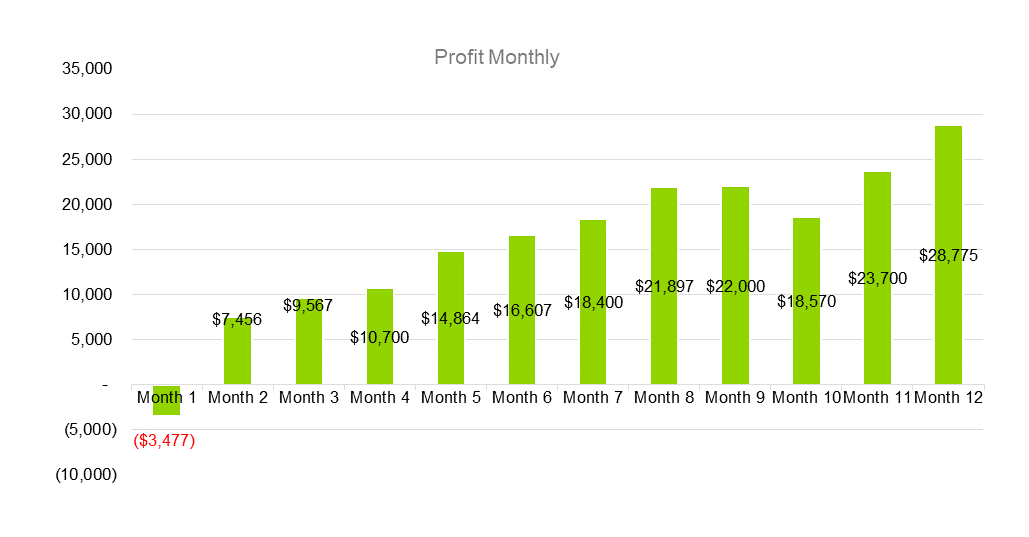
Profit Yearly
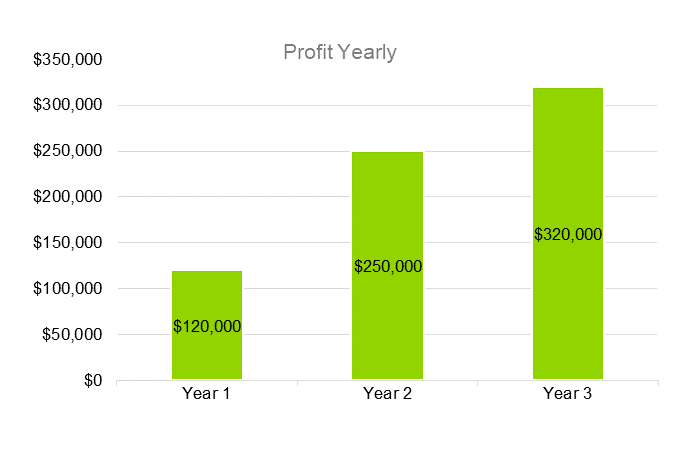
Gross Margin Monthly
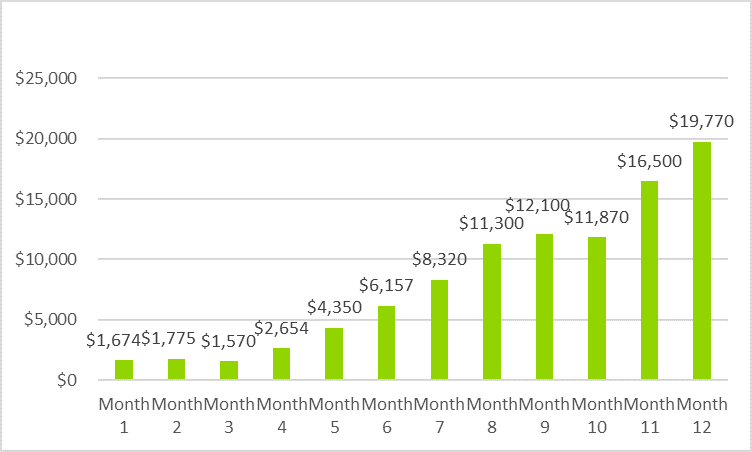
Gross Margin Yearly
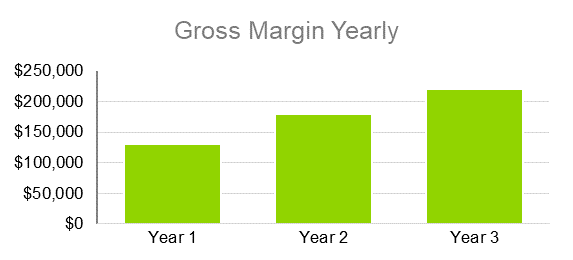
Projected Cash Flow
This column diagram illustrates cash flow projections.
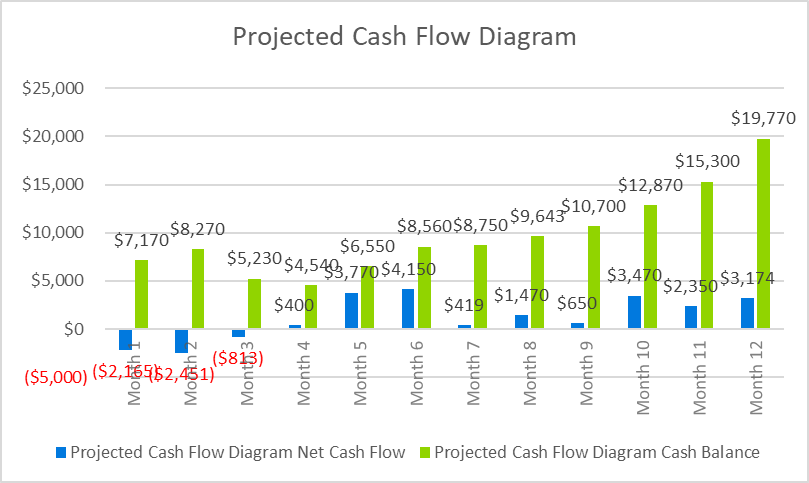
In the following table, you can find detailed information about pro forma cash flow. A subtotal cash flow statement includes subtotal cash received, subtotal operational expenditures, as well as general assumptions.
| Pro Forma Cash Flow | |||
| Cash Received | Year 1 | Year 2 | Year 3 |
| Cash from Operations | |||
| Cash Sales | $54,721 | $59,099 | $63,827 |
| Cash from Receivables | $22,679 | $24,493 | $26,453 |
| SUBTOTAL CASH FROM OPERATIONS | $77,400 | $84,366 | $91,115 |
| Additional Cash Received | |||
| Sales Tax, VAT, HST/GST Received | $0 | $0 | $0 |
| New Current Borrowing | $0 | $0 | $0 |
| New Other Liabilities (interest-free) | $0 | $0 | $0 |
| New Long-term Liabilities | $0 | $0 | $0 |
| Sales of Other Current Assets | $0 | $0 | $0 |
| Sales of Long-term Assets | $0 | $0 | $0 |
| New Investment Received | $0 | $0 | $0 |
| SUBTOTAL CASH RECEIVED | $76,573 | $79,765 | $82,346 |
| Expenditures | Year 1 | Year 2 | Year 3 |
| Expenditures from Operations | |||
| Cash Spending | $39,876 | $41,500 | $43,987 |
| Bill Payments | $25,700 | $27,500 | $29,500 |
| SUBTOTAL SPENT ON OPERATIONS | $65,576 | $69,000 | $73,487 |
| Additional Cash Spent | |||
| Sales Tax, VAT, HST/GST Paid Out | $0 | $0 | $0 |
| Principal Repayment of Current Borrowing | $0 | $0 | $0 |
| Other Liabilities Principal Repayment | $0 | $0 | $0 |
| Long-term Liabilities Principal Repayment | $0 | $0 | $0 |
| Purchase Other Current Assets | $0 | $0 | $0 |
| Purchase Long-term Assets | $0 | $0 | $0 |
| Dividends | $0 | $0 | $0 |
| SUBTOTAL CASH SPENT | $62,900 | $67,932 | $73,367 |
| Net Cash Flow | $22,200 | $23,578 | $24,987 |
| Cash Balance | $28,765 | $29,097 | $32,864 |
Projected Balance Sheet
The following is a projected balance sheet for a business plan consulting service showing total current assets, total long-term assets, total assets, current subtotal liabilities, total liabilities, and total capital.
| Pro Forma Balance Sheet | |||
| Assets | Year 1 | Year 2 | Year 3 |
| Current Assets | |||
| Cash | $293,742 | $328,991 | $361,890 |
| Accounts Receivable | $25,977 | $29,094 | $32,702 |
| Inventory | $4,321 | $4,840 | $4,900 |
| Other Current Assets | $2,577 | $2,587 | $2,587 |
| TOTAL CURRENT ASSETS | $326,617 | $365,512 | $402,079 |
| Long-term Assets | |||
| Long-term Assets | $9,765 | $9,765 | $9,765 |
| Accumulated Depreciation | $18,700 | $20,944 | $23,562 |
| TOTAL LONG-TERM ASSETS | $28,300 | $31,696 | $35,658 |
| TOTAL ASSETS | $354,917 | $397,208 | $437,737 |
| Liabilities and Capital | Year 4 | Year 5 | Year 6 |
| Current Liabilities | |||
| Accounts Payable | $19,800 | $22,176 | $24,926 |
| Current Borrowing | $0 | $0 | $0 |
| Other Current Liabilities | $0 | $0 | $0 |
| SUBTOTAL CURRENT LIABILITIES | $19,800 | $22,176 | $24,926 |
| Long-term Liabilities | $0 | $0 | $0 |
| TOTAL LIABILITIES | $16,700 | $18,704 | $21,023 |
| Paid-in Capital | $49,417 | $62,023 | $67,071 |
| Retained Earnings | $58,500 | $63,765 | $70,142 |
| Earnings | $174,000 | $189,660 | $208,626 |
| TOTAL CAPITAL | $338,217 | $378,504 | $416,713 |
| TOTAL LIABILITIES AND CAPITAL | $354,917 | $397,208 | $437,737 |
| Net Worth | $298,770 | $325,659 | $358,225 |
Business Ratios
Below is a table that shows internet radio business plan metrics, along with ratio analysis and a total assets breakdown.
| Ratio Analysis | ||||
| Year 1 | Year 2 | Year 3 | INDUSTRY PROFILE | |
| Sales Growth | 8.73% | 9.67% | 10.72% | 3.00% |
| Percent of Total Assets | ||||
| Accounts Receivable | 8.53% | 9.45% | 10.47% | 9.80% |
| Inventory | 6.33% | 7.01% | 7.77% | 9.90% |
| Other Current Assets | 3.21% | 3.56% | 3.94% | 2.40% |
| Total Current Assets | 148.30% | 146.00% | 147.00% | 153.00% |
| Long-term Assets | 12.52% | 11.55% | 11.59% | 11.70% |
| TOTAL ASSETS | 100.00% | 100.00% | 100.00% | 100.00% |
| Current Liabilities | 4.75% | 4.79% | 4.83% | 4.34% |
| Long-term Liabilities | 0.00% | 0.00% | 0.00% | 0.00% |
| Total Liabilities | 7.44% | 7.50% | 7.57% | 7.38% |
| NET WORTH | 100.06% | 100.86% | 101.79% | 110.00% |
| Percent of Sales | ||||
| Sales | 100.00% | 100.00% | 100.00% | 100.00% |
| Gross Margin | 95.65% | 98.23% | 100.98% | 99.00% |
| Selling, General & Administrative Expenses | 95.80% | 98.39% | 101.14% | 97.80% |
| Advertising Expenses | 1.53% | 1.57% | 1.62% | 1.40% |
| Profit Before Interest and Taxes | 41.90% | 43.03% | 44.24% | 33.90% |
| Main Ratios | ||||
| Current | 36 | 37 | 38 | 39 |
| Quick | 34 | 34.2 | 35.055 | 33 |
| Total Debt to Total Assets | 0.17% | 0.17% | 0.17% | 0.40% |
| Pre-tax Return on Net Worth | 72.68% | 74.24% | 75.00% | 75.00% |
| Pre-tax Return on Assets | 94.88% | 99.62% | 104.61% | 111.30% |
| Additional Ratios | Year 1 | Year 2 | Year 3 | |
| Net Profit Margin | 374.51% | 386.12% | 398.09% | N.A. |
| Return on Equity | 56.20% | 57.94% | 59.74% | N.A. |
| Activity Ratios | ||||
| Accounts Receivable Turnover | 7.9 | 7.9 | 8 | N.A. |
| Collection Days | 100 | 100 | 100 | N.A. |
| Inventory Turnover | 35.3 | 37.065 | 32 | N.A. |
| Accounts Payable Turnover | 15.9 | 17 | 16.3 | N.A. |
| Payment Days | 27 | 27 | 27 | N.A. |
| Total Asset Turnover | 2.45 | 2.5 | 2.6 | N.A. |
| Debt Ratios | ||||
| Debt to Net Worth | -0.05 | -0.04 | -0.05 | N.A. |
| Current Liab. to Liab. | 1 | 1 | 1 | N.A. |
| Liquidity Ratios | ||||
| Net Working Capital | $277,000 | $292,512 | $308,893 | N.A. |
| Interest Coverage | 0 | 0 | 0 | N.A. |
| Additional Ratios | ||||
| Assets to Sales | 0.8 | 0.87 | 0.89 | N.A. |
| Current Debt/Total Assets | 1% | 0% | 0% | N.A. |
| Acid Test | 28.06 | 28.12 | 28.75 | N.A. |
| Sales/Net Worth | 2.3 | 2.4 | 2.6 | N.A. |
| Dividend Payout | 0 | 0 | 0 | N.A. |
9. FAQ
How does a festival make money?
Festivals may make money through ticket sales, sponsorships, merchandise, concessions, and donations. They may also receive funding from local, state, and federal governments.
What makes a successful festival?
A successful festival is one that meets the needs of its audience. This means having a variety of activities and events to appeal to a wide range of people. It should also have a well-executed marketing plan to ensure the event is well-publicized and attract the right demographic. Additionally, a successful festival should have adequate facilities and safety measures in place to ensure attendees can enjoy themselves without worry. Finally, a successful festival should be well-organized and have an efficient staff to guide attendees and help make sure the event runs smoothly.




 (7 votes, average: 4.43 out of 5)
(7 votes, average: 4.43 out of 5)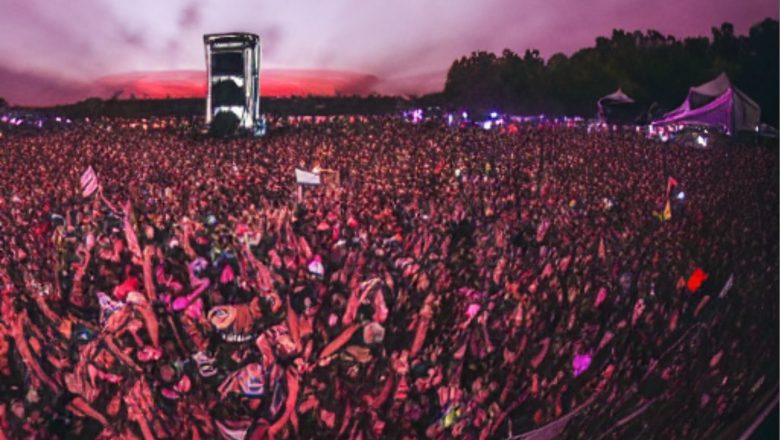





Add comment
Comments (0)